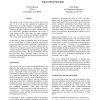Free Online Productivity Tools
i2Speak
i2Symbol
i2OCR
iTex2Img
iWeb2Print
iWeb2Shot
i2Type
iPdf2Split
iPdf2Merge
i2Bopomofo
i2Arabic
i2Style
i2Image
i2PDF
iLatex2Rtf
Sci2ools
127
Voted
ANSS
1991
IEEE
1991
IEEE
Supercritical speedup
The notions of the critical path of events and critical time of an event are key concepts in analyzing the performance of a parallel discrete event simulation. The highest critical time of any event in a simulation is a lower bound on the time it takes to execute a simulation using any conservative simulation mechanism, and is also a lower bound on the time taken by some optimistic methods. However, at least one optimistic mechanismis able to beat the critical path bound in a nontrivial way. In this paper we make a systematic study of the meaning of the critical path in parallel simulation, and describe criteria that determine when a simulation is bounded by its length and when it is not. We show (again) that no conservative mechanism can beat the critical path, but that at least four known optimistic mechanisms are all capable of supercritical speedup. We give performance data for the JPL Time Warp Operating System showing two specially constructed applications using different method...
| Added | 27 Aug 2010 |
| Updated | 27 Aug 2010 |
| Type | Conference |
| Year | 1991 |
| Where | ANSS |
| Authors | David R. Jefferson, Peter L. Reiher |
Comments (0)

